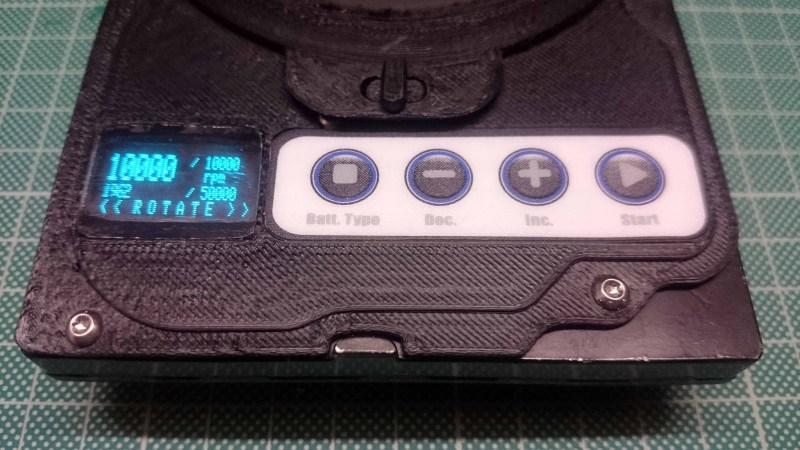Most of us can say that we have taken an obsolete hard drive out of a computer and felt it was a waste to toss it in the e-waste pile. Some of us have children’s drawings hung on the fridge with actuator magnets, or maybe a vast spreadsheet suspended on a steel filing cabinet. Let us not forget that there is also a high-speed, low-noise motor in there. On some models it is separate from the PCB, so grab an Electronic Speed Controller (ESC), your microcontroller of choice, and make yourself a salvaged HDD centrifuge like [Cave Man] has. His build uses the tray as a chassis, but he modeled and printed a new face in the same style as the original.
On top, he has an OLED screen for displaying the requested speed, measured speed, and runtime. Next to the display is a four-button pad with a customized legend for setting parameters. The video after the break shows the machine running through its paces. This version accommodates the tiny capillary tubes, microhematocrit tubes, for processing raw blood. This test can calculate the packed cell volume, which professionals use to determine things from dehydration to anemia.
There are other builds out there where people have modified an old drive into the kind of centrifuge that accepts larger diameter tubes, but this was a shining example of what is possible. One good turn deserves another, so we recommend a desktop bio-lab companion, or enlist some LEGO Mindstorms to help out.
















I would like to point out the drive board already has a motor driver, and most micro controllers are more than capable communicating with it.
I wondered about that too. Could it have a utilitarian purpose? I assume the rotor is significantly heavier and more unbalanced when it’s loaded up with certain samples; could it be a beefier motor driver to deal with greater inductive spikes and current going through the motor?
Or just because one was sitting around in the junk drawer and it’s easier to interface with a standalone than partially reverse-engineer the stock drivers? Of course if that’s the case and it’s an open-source project meant to be replicated, it would be most helpful to reduce that BOM for others. I know I’m also often tempted to use convenient but expensive parts because they’re already here collecting dust.
the drive board has a Lot going on already that you may not want waking up when you engage with the motor, if your skills are even up to the task of locating and interfacing with the Very Small Parts already on the board. using an external driver bypasses the reverse-engineering of the original driver, it all depends what your skills are, what you want to do, and what you want to prove to yourself you can do
Also, the drives I’ve encountered tend to lack datasheets for their motor drivers. I believe they are custom parts for HDD makers. Without a datasheet, it’s fairly pointless to try and reuse the driver.
A dvd or cd rom drive makes an excellent base for this sort of blood analysis. a disposable CD is created with the tiny capillary tubes and other features molded into the disk. The optical portions of the drive can be used to read out fluorescent markers.